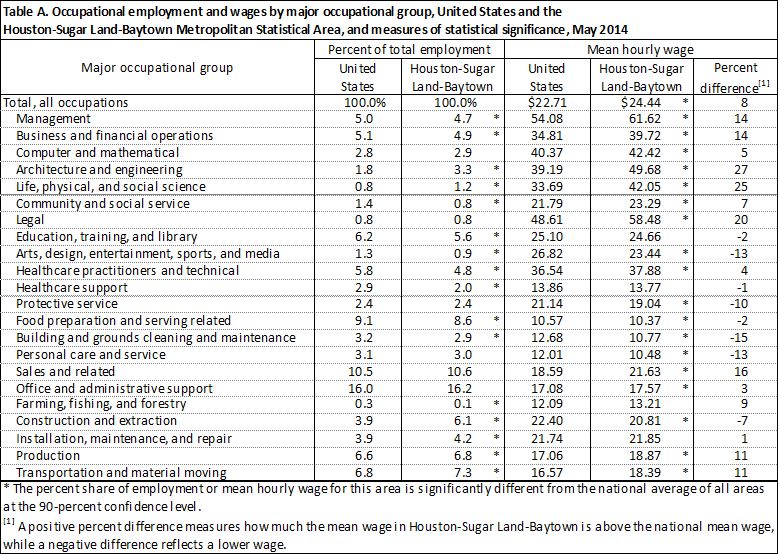
Courtesy of U.S. Bureau of Labor Statistics
OCCUPATIONAL EMPLOYMENT AND WAGES IN COLLEGE STATION-BRYAN, MAY 2014
Workers in the College Station-Bryan Metropolitan Statistical Area had an average (mean) hourly wage of $20.09 in May 2014, about 12 percent below the nationwide average of $22.71, according to the U.S. Bureau of Labor Statistics. Regional Commissioner Stanley W. Suchman noted that, after testing for statistical significance, wages in the local area were higher than their respective national averages in only 1 of the 22 major occupational groups: education, training, and library.
Seventeen groups had wages measurably lower than their respective national averages; included in this group were life, physical, and social science; computer and mathematical; and architecture and engineering.
When compared to the nationwide distribution, College Station employment was more highly concentrated in 6 of the 22 occupational groups including education, training, and library; food preparation and serving related; and life, physical, and social science. Conversely, 9 groups had employment shares significantly below their national representation, including transportation and material moving; production; and business and financial operations.

One occupational group – education, training, and library occupations – was chosen to illustrate the diversity of data available for any of the 22 major occupational categories. College Station had 10,640 jobs in education, training, and library occupations, accounting for 10.8 percent of local area employment, significantly higher than the 6.2-percent national share. The local average hourly wage for this occupational group was $31.96, nearly 30 percent above the national average of $25.10.
With employment of 1,830, graduate teaching assistants was one of the largest occupations within the education, training, and library occupations group, as were elementary school teachers, except special education (1,210) and teacher assistants (790). Among the higher paying jobs were postsecondary engineering teachers and postsecondary agricultural sciences teachers, averaging a mean annual wage of $141,990 and $109,310, respectively. At the lower end of the wage scale were teacher assistants ($19,910) and graduate teaching assistants ($36,870).
Location quotients allow us to explore the occupational make-up of a metropolitan area by comparing the composition of jobs in an area relative to the national average. For example, a location quotient of 2.0 indicates that an occupation accounts for twice the share of employment in the area than it does nationally.
In the College Station metropolitan area, above average concentrations of employment were found in many of the detailed occupations within the education, training, and library group. For instance, postsecondary agricultural sciences teachers were employed at 91.0 times the national average in College Station, and postsecondary architecture teachers, at 29.0 times the national rate.
Both location quotients were among the highest in all metropolitan areas for these particular occupations. On the other hand, secondary school teachers, except special and career/technical education had a location quotient of 1.0 in College Station, indicating that this occupation’s local and national employment shares were similar.
These statistics are from the Occupational Employment Statistics (OES) survey, a federal-state cooperative program between BLS and State Workforce Agencies, in this case, the Texas Workforce Commission.
Click below to hear comments from Cheryl Abbott visiting with WTAW’s Chelsea Reber.
